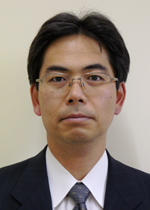Professor Takahiro Tanaka from the Yukawa Institute for Theoretical Physics and Program-Specific Associate Professor Satoshi Hirata from the Primate Research Institute will be awarded this year's Japan Academy Medal.
The Japan Academy Medal is awarded to young researchers with outstanding achievements who show especially great promise while encouraging them in their future work. Up to six awardees are selected from among the recipients of the JSPS Prize for the year, who are expected to contribute particularly to the advancement of science in Japan.
The award ceremony will take place on February 27, 2012 (Monday) at the Japan Academy.
Professor Takahiro Tanaka (Yukawa Institute for Theoretical Physics)

Professor Takahiro Tanaka graduated from Kyoto University's Faculty of Science in March 1990 and earned his Ph.D. in science from Kyoto University in March 1995. His academic positions in the following years include JSPS postdoctoral research fellow at Kyoto University in April 1995; assistant professor at Osaka University's Faculty of Science in August 1995; assistant professor at Osaka University's Graduate School of Science in April 1996; associate professor at Kyoto University's Yukawa Institute for Theoretical Physics in April 2000; and associate professor at Kyoto University's Graduate School of Science in May 2003, before he was appointed professor at the Yukawa Institute for Theoretical Physics in April 2008.
The medal will be awarded for his research on the "Gravity of Brane-World."
Professor Tanaka has conducted a number of pioneering, systematic studies concerning the behavior of gravity in the brane-world model and has made internationally-acclaimed achievements. The physics of spacetime was initiated by Einstein in his theory of general relativity, and its validity in classical terms has been proven by various observations. By contrast, according to the new cosmology based on string theory, known as the "brane model," it has been predicted that spacetime has more than four dimensions and that our universe is realized on a 3+1-dimensional membrane-like object moving inside, referred to as a "brane." Professor Tanaka has been leading the development of this new cosmology. If our "brane" is inside spacetime with more than four dimensions, gravity should propagate along the brane as well as through the extra dimensions. Consequently, the law of gravitation deviates from Einstein's theory with respect to the gravity observed in the world inside the brane where we live. Professor Tanaka developed a new perturbative computation scheme to study this deviation precisely, and his results can be used to quantitatively capture the evidence of extra dimensions through observations for the first time. His research achievement has been recognized to be epoch-making in this respect.
In addition, he predicted that the application of a hypothesis regarding the equivalence between a brane universe and four-dimensional Einsteinian gravity, along with a strongly coupled conformal field theory system, to a black hole on a brane results in no static black hole solution, which provoked sensational debates. Meanwhile, concerning gravitational waves, he also derived a fundamental equation on the gravitational reaction force received by a low-mass binary star when the other binary star is a black hole and created a template of gravitational waves generated from combined binary starts, contributing to the formulation of observation plans.
These research achievements have gained extremely high evaluations within the Japanese and international research community, which is the reason for the award of the medal.
Program-Specific Associate Professor Satoshi Hirata (Primate Research Institute)

Program-Specific Associate Professor Satoshi Hirata graduated from Kyoto University's Faculty of Science in March 1996 and earned his Ph.D. in science from Kyoto University in March 2001. His academic positions in the years that followed include SPS postdoctoral research fellow at Kyoto University in April 2001; senior researcher at the Hayashibara Biochemical Laboratories, Inc. Great Ape Research Institute in May 2002; and chief researcher at the Great Ape Research Institute in April 2008, before he was appointed program-specific associate professor at Kyoto University's Primate Research Institute in September 2011.
The Japan Academy Medal will be awarded for his research, titled "Quest for the Evolutionary Origins of Social Intelligence through the Comparative Cognitive Studies in Humans and Chimpanzees," recognizing his unique research achievements from the viewpoint of discerning the phylogenetic foundation of social intelligence through research in chimpanzees.
Program-Specific Associate Professor Hirata has clarified the similarities and differences in social intelligence between humans and chimpanzees through a series of innovative research by constructing scenes for unconventional, unique social experiments in which he observed the manifestation and development of deceptive behaviors, cultural propagation of tool-use behaviors from parents to children, manifestation of cooperative behaviors, and communication involved therein in chimpanzees. His experimental research in cooperative behaviors, in particular, used an internationally known sophisticated apparatus he devised to make a breakthrough in the research. He also undertook many other unique research activities, including the first experiment to verify their cognition of self and others based on the electroencephalogram measurements of chimpanzees and a study on the development of cognitive functions in a fetus within the womb using a 4-D echo system.
These achievements have been published in first-class peer-reviewed international journals and cited by many researchers, which constitutes the reason for the award of the medal.

